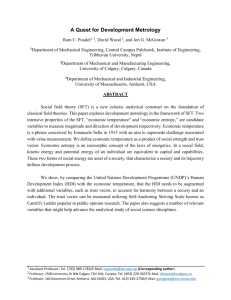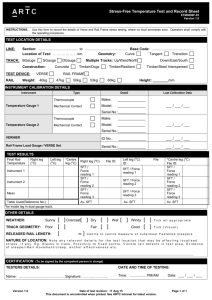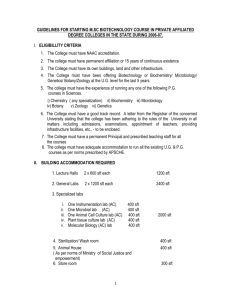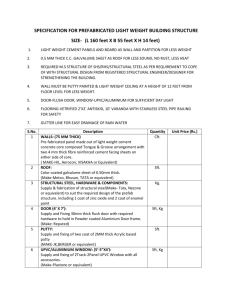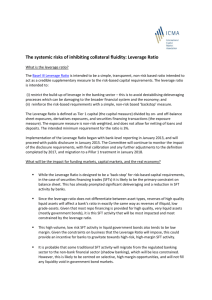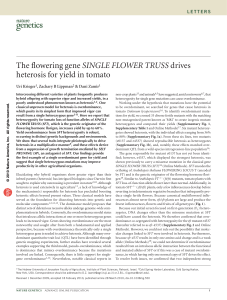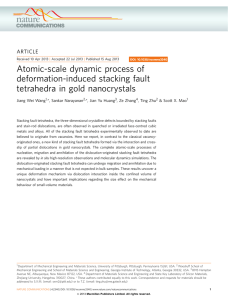Maria Alessandra Papa
advertisement
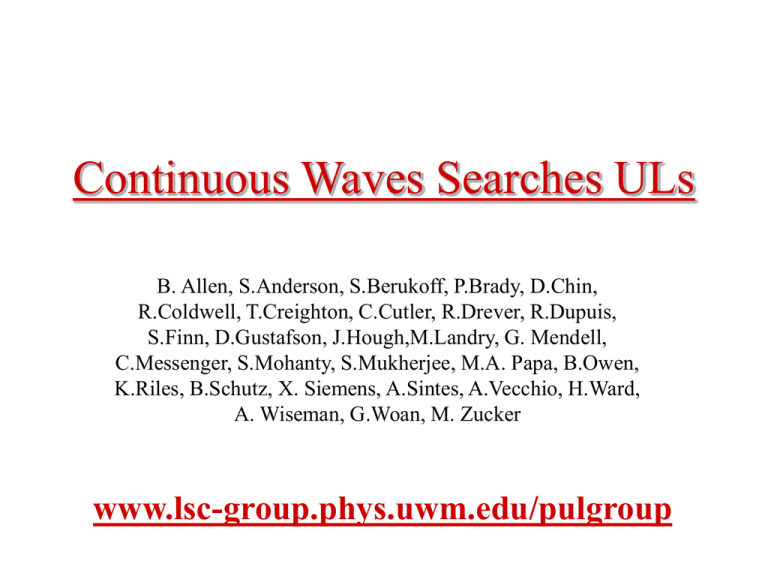
Continuous Waves Searches ULs
B. Allen, S.Anderson, S.Berukoff, P.Brady, D.Chin,
R.Coldwell, T.Creighton, C.Cutler, R.Drever, R.Dupuis,
S.Finn, D.Gustafson, J.Hough,M.Landry, G. Mendell,
C.Messenger, S.Mohanty, S.Mukherjee, M.A. Papa, B.Owen,
K.Riles, B.Schutz, X. Siemens, A.Sintes, A.Vecchio, H.Ward,
A. Wiseman, G.Woan, M. Zucker
www.lsc-group.phys.uwm.edu/pulgroup
Science activities
Plan of the talk
• first priority item: UL on signals from known sources:
• two search engines:
- frequency domain
- time domain (presented by G. Woan , Glasgow)
• preliminary S1 investigations
• other tasks that might meet the end-of-the year deadline:
• UL on Sco-X1 (Birmingham)
• Unbiased searches (Michigan)
Frequency domain search: general overview
• core LAL routines: LALDemod, LALBarycentering, LALComputeSky
(AEI)
• given template parameters and data in frequency domain (SFTs) it
computes the F statistic
• can be used for targeted searches, for area searches and as a module of a
hierarchical search
• efficient algorithm to run in a (cheap) distributed computing environment
• there exists an LDAS DSO that runs on (LDAS-produced) SFTs, performs
the search and write to the data-base table (G. Mendell)
• what is F and how we compute it
• how we go from F to an UL
F statistic from gr-qc/9804014, P. Jaranowski, A. Krolak, B.F. Schutz
Signals model and parameters
isolated rotating pulsar emitting GWs at f0=2fr due to its
configuration not being perfectly axysimmetric
• (a,d)
position in the sky
• f0
emission frequency (at SSB)
• {fs}
spin-down parameters,
• h0
amplitude of signal (as received on Earth)
•i
inclination angle
•y
polarization angle
• f0
initial phase
How does the signal that we receive depend on
these parameters?
h(t) F (t ) h (t ) F (t ) h (t )
F (t )
F (t )
beam-pattern functions and depend on the relative
orientation of the detector w.r.t. the wave. They depend on y
and on the amplitude modulation functions a(t) and b(t) that
depend on the relative instantaneous position between source
and detector.
h ( t ) 12 h 0 (1 cos 2 i ) cos 2 (t)
h ( t ) 12 h 0 cos i sin 2 (t)
(t) Φ0 Φ (t )
the two independent wave
polarizations.
the phase of the received signal depends on the
initial phase and on the frequency evolution of
the signal. The latter depends on the spin-down
parameters and on the Doppler modulation,
thus on the frequency of the signal and on the
relative instantaneous relative velocity between
source and detector.
What is the F statistic ?
Given the values of the position in the sky, f0 and the spin-down
parameters, the F statistic is a number: the maximum of the
likelihood ratio. It is the likelihood ratio computed for the
maximum likelihood estimators of (h0,i,f0,y), i.e. the values that
maximize F, given the data set.
We do not need to explicitly search over h0,i,f0,y. Given the data,
F is the likelihood ratio for the quadruplet of values that best fits
the data. This maximization is done analytically.
As we will see, if a signal were present, the actual value of F
would depend, of course, on the actual value of the signal’s
h0,i,f0,y parameters.
Why can we compute F efficiently ?
• the core of the calculation consists in computing
| xi e f i |
i
i
with fi being the phase of the signal (template) and
xi being the data.
Let’s neglect for now the amplitude modulation. It’s irrelevant for the point
I am making now.
Input data in frequency domain
TOTAL DATA SET:
Sampling rate ~ 2kHz
Our data: NM samples
Tobs ~ 4 months
Size: ~ 80 GB
MN
. . . . . . . . . . . .
1
t
Band 0-1 kHz at 1e-7 Hz
resolution.
Can also be divided in M chunks, each one having N samples. Each of
these chunks can be FFT-ed, producing a set of short time-baseline
FFTs (SFTS):
FFT
the chunks
.....
.....
.....
.....
~
x 1k
1
N
~
x 2k
1
N
~
x 3k
1
N
.
.
.
.
~
xMk 1
N
1
2
EACH CHUNK:
3
.
.
.
.
M
Duration of a chunk ~ 1 h
In 4 months ~ 3000
chunks
Each chunk ~28 MB
Band 0-1 kHz at 3E-4 Hz
resolution.
The core of the calculation looks like this:
M
1
a Sa ( f 0)
N
e ~
x
a Da
a S (f )
k
k
Hz
k3
k
~
e
x a Da
k 8
Hz
k
0
Hz
a
ya
i
2
D
k
......
k1
f0
1k
k
Hz
ya
i
1
M
kM
f0
D 2k
f0
D3k
f0
DMk
Dak is the Dirichlet kernel centered at the instantaneous freq. at the
mid time of every SFT (k*).
Including the amplitude modulation
F f 0 ai x e
a
f
i
( f 0)
i
( f 0)
ai and bi are the amplitude
modulation functions that
only depend on the
template sky-position.
i
i
f
f
F 0 bi x e
b
i
i
i
i
To construct F one has to combine Fa and Fb like this:
2
2
A|F ( f 0)| B |F ( f 0)| 2C |F a ( f 0) F b ( f 0)|
F ( f 0)
D
a
b
In every SFT the ai and bi can be considered constant. Thus we
only have to multiply each SFT datum by the same number
(different for each SFT)
we do not need to modify our
demod. scheme
How is F distributed ?
• in the case of noise only, F is expected to be a c2 random
variable with 4 degrees of freedom.
• if there’s a signal, F is expected to follow a non-central c2
distribution with non centrality parameter proportional to inner
product of signal with itself.
By studying how values of F(f0) computed for f0s different
from those of the targeted signal are distributed, we can verify
that our data follows the expected noise-only distribution.
If it does not, we will take the measured distribution as the
actual one.
Presumably we will obtain a value of F from our search that lies
well within the noise curve
we want to set an UL on h0.
Preliminary results on F
F from 4 H2 S1 2048 s SFTs - IFO always locked - GPS 714887312 –714895504.
distribution of F and fit to c2 with
4 deg. of freedom
0.128 Hz band around 1282.86 Hz.
f0
fake pure gaussian noise passed
through search code
by G. Mendell and
B.Cameron
data
ANALYSIS
PIPELINE
F*
the result of our analysis
a,d,f0,{fs}
According to our
analysis, with YYY
confidence, this pulsar is
not emitting GWs (of the
type that we are looking
for) with h0 greater than
XXX.
There are many ways to set upper limits
Most conservative upper limit - a curve not a number !
F*
the result of our analysis.
If there’s a signal, the distribution
depends of the signal’s i,y,f0 and h0
parameters.
pw (F| h0=1)
20%
pw (F| h0=2)
Let us choose the triplet i,y,f0 that yields
the smallest non-centrality parameter:
iw,yw,f0w .
Now the distribution only depends on h0:
pw (F| h0).
80%
F*
It is a sample of a random variable drawn
from a certain distribution. Which
distribution ?
For every values of h0 we can integrate
the corresponding pw (F| h0) curve
between F* and infinity, this yields
P(h0), our final UL result:
with probability (confidence) P we can say that if the data contained a signal with
amplitude h0 (or greater), we would have measured a value of F higher than the one that
we have measured (F*).
We could set more “liberal” UL by eliminating the
dependency from the i,y,f0 parameters differently:
• we could construct the p(F|h0) by integrating p(F | h0, i,y,f0 ) over the
values of i,y,f0 , with suitable weights, i.e.prior. This method, in general,
will produce a stronger (lower) UL than the previous one presented.
• It has also been suggested that we construct, just to provide “a feel” for
the range of variability of our UL, also a “least conservative UL”. To
compute this UL one follows the same recipe as for the most conservative
UL, with the exception that the values of i,y,f0 are the ones for which the
non-centrality parameter is maximum.
• all of the methods proposed up to here are essentially Frequentist ULs.
The time-domain analysis will use a Baysian approach. In the case of
known pulsars we do not expect that the two approaches will provide
significantly different results.
Where do we stand now ?
• constructing SFT data and looking at it
• validating software pipeline to compute F
• developing software for extensive Monte Carlo on real data
to assess detection efficiency and estimate pdfs (might not be
necessary, but certainly it is necessary to check that that’s the
case)
• want to meet end of the year UL deadline
Power in 4 H2 S1 2048 s SFTs
(IFO always locked; GPS 714887312 - 714895504)
2 Hz band centered on 1283.86 Hz
The mean power goes increases by 13% increase during this interval
by G. Mendell
Power in 4 H2 S1 64 s SFTs
(IFO always locked; GPS 714887296 - 714887552)
2 Hz band centered on 1283.86 Hz
The mean power appears to increase by a factor of 12 during 2048 seconds
Low frequency power “leaking out” -> high-pass filtering or windowing needed
with such short time-baselines
by G. Mendell
Gaps in lock: GPS 714162320 - 714170512
Power in 4 H2 S1 2048 s SFTs
padded gaps in lock
Histograms
by G. Mendell
GEO - 10 SFTs - 60 s - 10 Hz band @ 1283 Hz
|SFT|^2/<|SFT|^2>
|SFT|^2/<|SFT|^2>
with windowing before
FFTing
LIGO H1 - 1800 SFTs - 64 s 1 - Hz band @ 1283 Hz
starting at 714151671
|SFT|^2/<|SFT|^2>
<|SFT|^2> and s(|SFT|^2)
|SFT|^2/<|SFT|^2>
having removed the
mean
B. Allen’s SFTs
More S1 investigations
Unbiased CW Searches. Strategy (Michigan):
• Measure power in selected bins of averaged periodograms
• Bins defined by source parameters (f, RA, d)
• Estimate noise level & statistics from neighboring bins
• Set upper limit on quasi-sinusoidal signal on top of empirically determined
noise
• Scale upper limit by antenna pattern correction
They have started to study the average spectral power
distribution of the 2048s LDAS-produced SFTs
Probably not optimum, but fine for exploration
Upper limits will be based on excess power summed incoherently over
subsets of bins in many SFT’s
Study Range: 659-661 Hz (early H1)
Early H1 – Average over 97
SFT’s with >90% livetime
Bottom histogram now excludes
region between bars
Same but with 5 mHz
binning (“typical”
Δf searchband)
D. Chin, K. Riles
Study Range: 659-661 Hz (late H1)
Late H1 – Average over 146
SFT’s with >90% livetime
Same but with 5 mHz
binning (“typical”
Δf searchband)
Bottom histogram now excludes
region between bars
Cleaner than
early H1 !!
D. Chin, K. Riles
Preliminary conclusions from unbiased search team that
in spirit apply to all S1 investigation:
• At least some of the data looks “okay” – Gaussian, locally
white noise not a terrible approximation
• But non-Gaussianity and non-stationarity quite apparent
and must be confronted
• But devil is in the details:
– Optimization of SFT’s (ΔT, windowing)
– Determining detection efficiency:
– Correction for calibration drifts
Expect analysis to evolve in iterative refinements but on a
time scale that will allow us to meet our end-of-the-year
deadlines, as promised.

